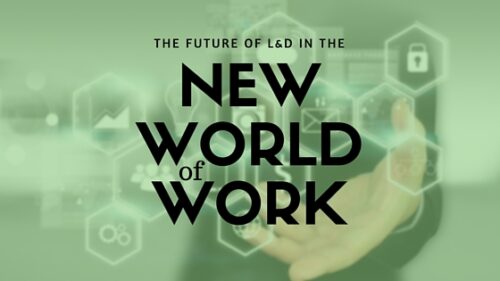The Future of L&D in the New World of Work
This article from HBR.org got me thinking more about how Training, Learning and Development fit into the future of work. Over the years there have been a few research organizations looking into the future of the workplace. But this particular look into the future comes from a unique perspective.
The article is built upon the work of a consortium called CHREATE :
“Important clues are emerging from a unique consortium of human resource executives and other leaders. They have gathered through CHREATE (the Global Consortium to Reimagine HR, Employment Alternatives, Talent, and the Enterprise) to map how organizations must evolve to meet future challenges, to identify pivotal initiatives to accelerate that evolution, and to design the actions needed to make the future a reality.”
They have identified 5 fundamental forces driving the changes in business organizations. I’ll let you read the details if you are interested. Here is the list:
- Exponential Technology Change
- Social, Organizational Reconfiguration
- A Truly Connected World
- All-inclusive Talent Market
- Human-machine Collaboration
I think all five of these forces have already been identified in other posts, forums, etc. And so, these feel self-explanatory to me. However, if you’d like to read more deeply into how the consortium views these driving forces, then navigate to the link above before continuing.
The 4 Quadrants of the Future of Training, Learning and Development
The part I find most interesting is their 4 quadrant depiction of the future. Along the x axis is Technical Empowerment from low to high. And on the y axis is the Democratization of Work from low to high. You can view the chart here.
Democratization and Tech Empowerment are driving disruption in L&D [tweet this]
We often talk about how technology is disrupting the world of corporate training, learning and development. And we also talk about how the internet has democratized…well… everything! And learning is certainly not exempt from the effects of either one. It very interesting to see how HR professionals collectively have integrated both trends into a picture of 4 different types of work environments. I think I’ve had experiences in all 4 to some extent.
The HRB.org article does a great job of describing each of the 4 types from the level of the organization. What I’d like to do here is look at the same 4 types but directly how they relate to the work of Training and L&D organizations.
The Current State of Training, Learning and Development
I love that they put the current state of work as part of the future of work. I think that all too often we envision future states, or innovations, as eliminating the old state. In some case that may be true. But in the case of training, the classroom is here to stay despite futurists claiming the contrary back in the ’90s. Many training departments are functioning quite well in their current state. And in larger companies, with L&D organizations, the status quo is getting the job done. There are plenty of reasons why they might want to transition to newer learning solutions, and some are doing exactly that. But they also have the luxury of a working system that keeps the business running while they experiment with newer, more innovative alternatives. The current state of training will absolutely continue into the future for some businesses.
The Current State of the Turbo-charged Training, L&D Department
This type of future training department seems to be the fastest growing from my perspective. Along the x axis of technology empowerment we are seeing many companies turn away from traditional LMS’s and opting for easier, more flexible, and powerful, cloud-based LMSs, like Litmos. In some cases individual departments are taking ownership of their training by going rogue: Buying their own cloud-based LMS, despite the company having one of the larger more unmanageable legacy systems. Turbo-charging the training department with a tool like Litmos gives you the ability to automate much of your existing administrative work, continue to use current methods and models, but also enjoy the power of a platform being built for the future.
The Reimagined Learning Department
In this quadrant we see a high democratization of work. Training departments are experiencing this as well. The need for training continues to grow, and the current training design/development processes struggle to keep up. So many organizations, departments, teams, and individuals are taking matters into their own hands. Waiting for the L&D department, or training department to get the resources to fund your need is no longer an option. It’s much easier to simply do the training yourself. It’s easier than ever for individuals to share their knowledge and teach others what they know. We see it all over web sites like Youtube. Everyone has something they can teach others. And today, the technology exists to empower those motivated enough to just do it. The democratization of learning is a major disruptor and this type of workplace learning culture will begin to grow as the next generation moves into these jobs.
Uber Learning and Development
This quadrant is the holy grail we all seek. Today’s futurists speaking at Training, Learning and Development events across the globe pontificate about this future. A future where everything is Uber-fied, robotized, and virtualized. This is also a future where we see a strong, independent learning culture fully matured. A learning culture where learning is simply part of the work, and everyone is self motivated to learn from, and teach, each other. It sounds like a utopian workplace that may be unachievable. However, there are a few orgs very close to this future today. This future still includes a Learning and Development organization but the role we play is dramatically different from what it is today. Just how dramatic that difference is remains to be seen. Perhaps is a new role as curator of content. Or maybe even our new authoring tools will include the ability to quickly create virtual reality learning experiences. It’s possible. I’ve seen what can be done. We are not that far away from uber learning and development.
What Quadrant is Your Training Department In?
I’m sure you’ve been thinking about this question while reading. If not, then think about it for a moment. Where are you today? And which direction is your strategy taking you? Are you seeing more democratization, or tech empowerment, or both? I’d love to hear what you think.





